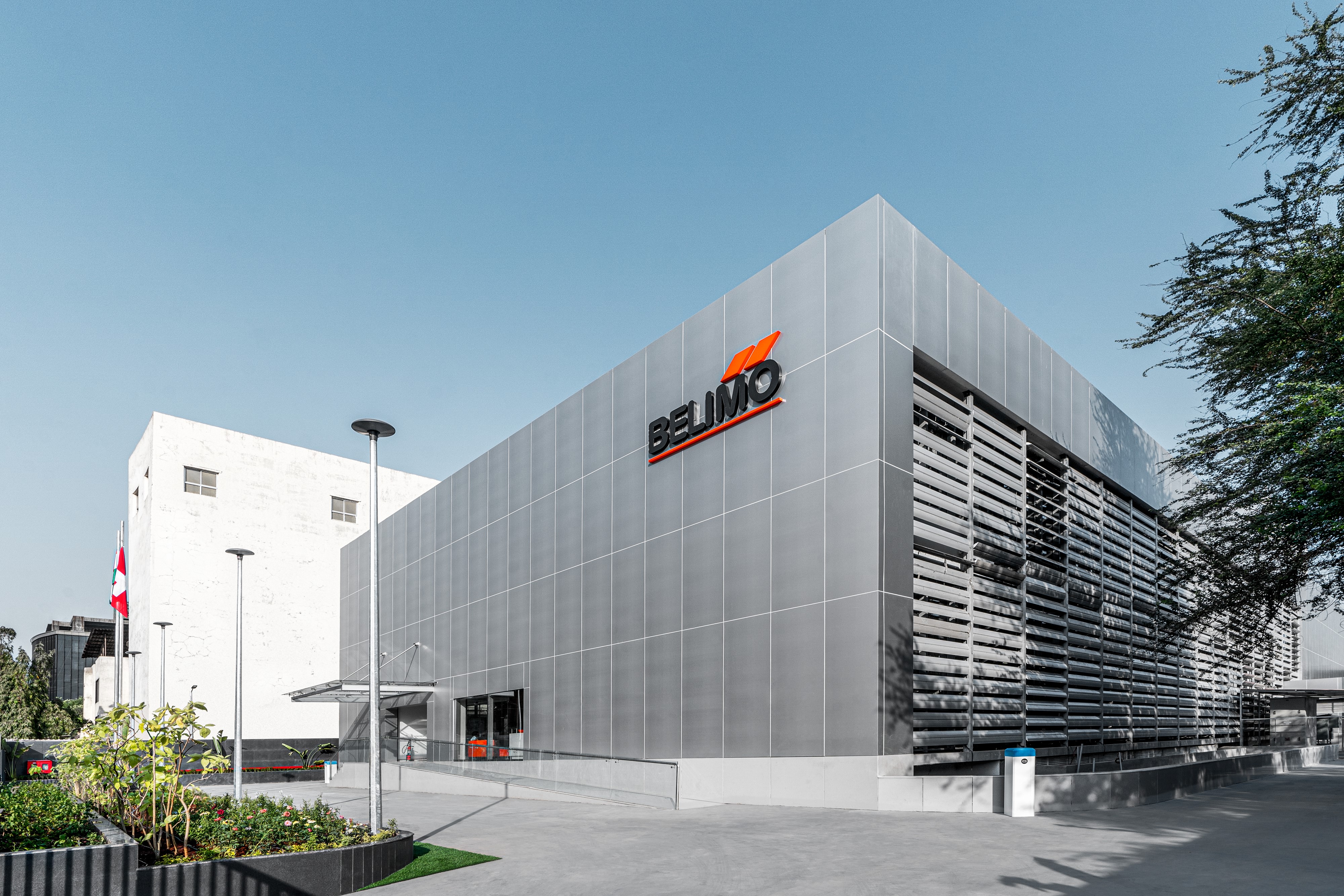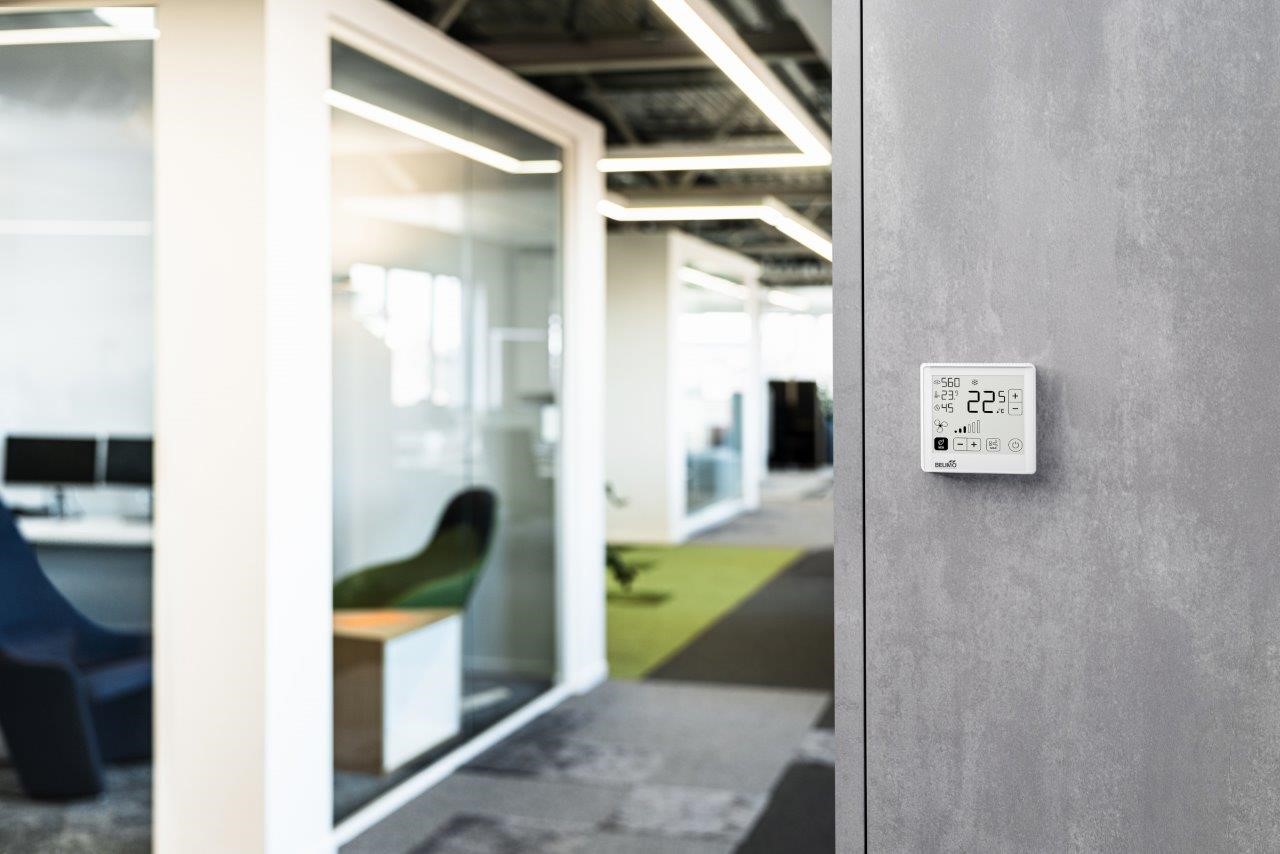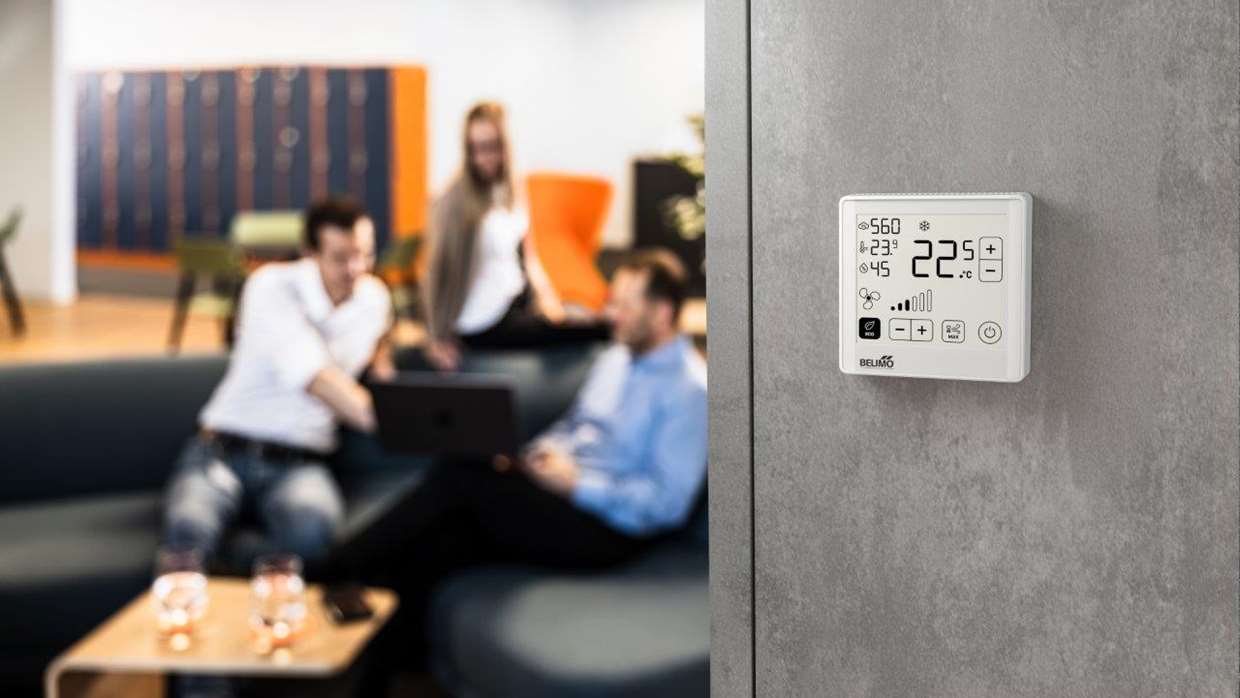
“You Can’t Manage What You Don’t Measure”
In August 2022, Belimo launched a new product line of room sensors and room operating units, expanding its range of HVAC sensors. These intelligent field devices not only form the foundation of indoor air quality – crucial for ensuring the health and productivity of building occupants – but they also improve the energy efficiency of the systems in which they are installed.
People spend almost 90% of their time indoors, inhaling air that is affected by the surroundings. The main method for controlling indoor air quality (IAQ) in buildings is with heating, ventilation, and air-conditioning (HVAC) systems. Pipe, duct, and room sensors serve as the critical link between the indoor environment and the HVAC system and help ensure optimal indoor air conditions. In late summer 2022, Belimo launched a new range of room sensors and room operating units to complement its existing portfolio. These field devices accurately monitor IAQ and can be integrated seamlessly into existing building management systems.
Key Health Factor Relative Humidity
Belimo sensors help provide a comfortable, productive, and healthy indoor climate by precisely measuring three critical parameters of indoor air: temperature, relative humidity, and CO2. Temperature as well as relative humidity impact comfort, productivity, and health.
The Effects of Different Relative Humidity Levels
It is crucial that a relative humidity between 40 to 60% is maintained as this affects the suspension time of aerosols in the air and influences the body’s ability to protect itself against environmental changes. In dry air (below 40% relative humidity), droplets from an infected person speaking or sneezing easily evaporate, and the contained virus travels further in the room as a light aerosol.
With a relative humidity level above 40%, droplets do not evaporate as quickly and fall to the ground at a shorter distance. In addition, many bacteria and viruses are considerably more contagious in dry air, as mucous membranes dry out when there is a lack of moisture, weakening the immune system.
Linking CO2 and Health
Although CO2 is a natural component of the air we breathe – making up approximately 0.04% of the earth’s atmosphere – extremely high concentrations of CO2 can be detrimental to health. CO2 concentrations of more than 1’000 parts per million decrease the human brain’s ability to concentrate. CO2 concentrations at 2’000 parts per million or higher can even lead to fatigue and headache.
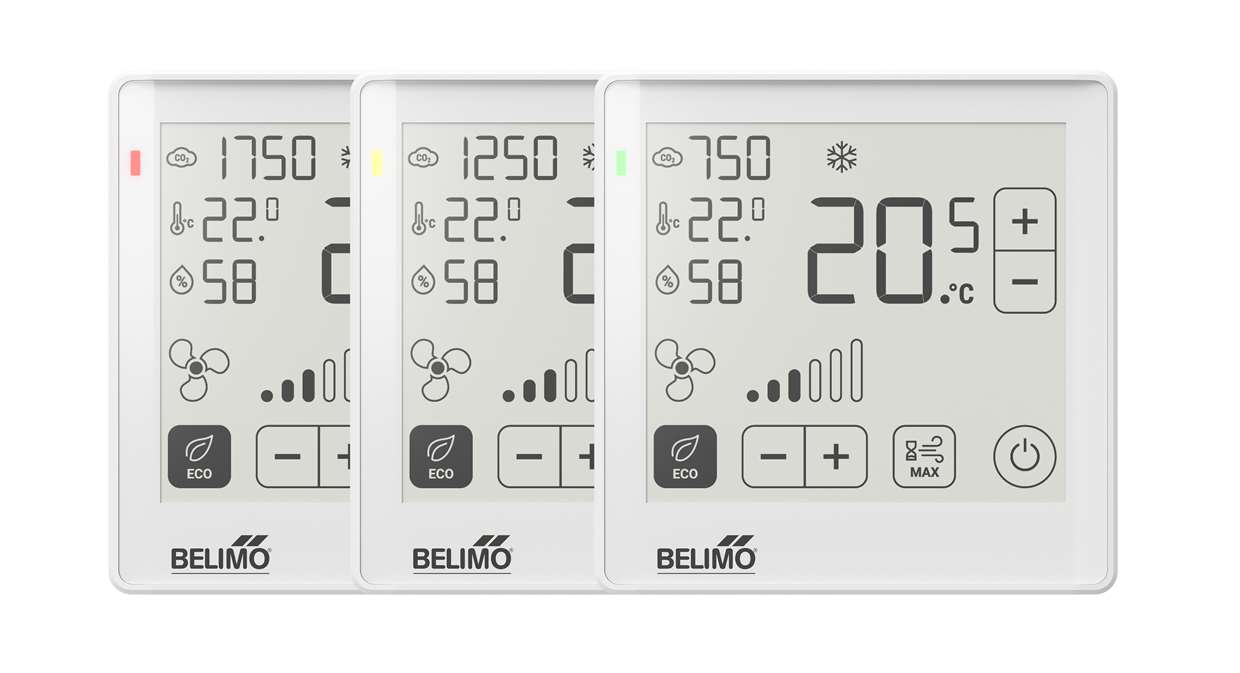
The CO2 level in a room provides an excellent gauge of overall IAQ and building occupancy, making it a highly attractive guide for demand-controlled ventilation. If the CO2 value is high due to increased occupancy and limited air exchange, there is also a greater potential risk of infectious aerosols.
This is why the new Belimo room operating units feature an LED traffic light function that clearly visualizes CO2 levels. In fact, temperature, relative humidity, and CO2 are all displayed on the high contrast ePaper touch display. The minimalist design principles in combination with these outstanding features were key factors that led to this technically mature product solution receiving the coveted Red Dot Design Award.
Linking IAQ and Energy Efficiency
“It’s an axiom that you cannot manage what you do not measure,” explained Bill Bahnfleth, Professor of Architectural Engineering at Penn State University, where he teaches courses on HVAC systems and specializes in IAQ research. “Information from HVAC sensors is vital to monitor the indoor climate and can be used to enhance IAQ in many ways.”

This includes checking the levels of key contaminants in the air, whether it is volatile organic compounds (VOCs), which are emitted by carpets and other materials containing organic adhesives, or particulate matter (PM), that can enter buildings from outside or can result from cooking. Bill agreed: “It is important to know what contaminants are in the indoor air so that we can manage them properly.”
Managing these contaminants comes down to turning on the ventilation, which is, in effect, conditioning exterior air to match interior conditions, including temperature and relative humidity. Again, control is key and relies on sensors to check that the level of ventilation is set correctly to meet indoor targets.
Bill continued: “Bringing lots of outdoor air into a building is tremendously inefficient, increasing energy costs. We do not want to over ventilate, just as much as we do not want to under ventilate.” Belimo takes all these factors into account, specializing in synchronizing sensors and actuators with HVAC systems to monitor contaminant levels and create an optimal supply of fresh exterior air and removal of contaminated air, while improving energy efficiency in the process.
Only 0.08% of HVAC Spending
One of the main factors in maintaining IAQ is keeping air moving. “In general, we want air to move from clean to less clean conditions,” Bill said. This requires good airflow control, which, in turn, relies on the control of air pressure between different zones in a building. To this end, Belimo sensors measure air pressure and flow through ducts, as well as relative humidity, CO2, and VOCs. The information they collect can be used to control the amount of air delivered to different zones and maintain the correct pressure gradient between them.
This whole approach is both energy efficient and effective in maximizing wellbeing and productivity indoors, simultaneously generating an incredible return on investment, especially as sensors account for only about 0.08% of a building's total HVAC spending.
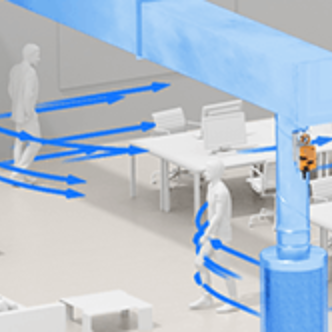 The Seven Essentials of Healthy Indoor Air
The Seven Essentials of Healthy Indoor AirBelimo interviewed consulting engineers and ventilation experts worldwide to identify systematic, practical, and comprehensive approaches for creating healthy indoor air. This resulted in the seven essentials of healthy indoor air, i.e., the most critical factors for ensuring IAQ in non-residential buildings.
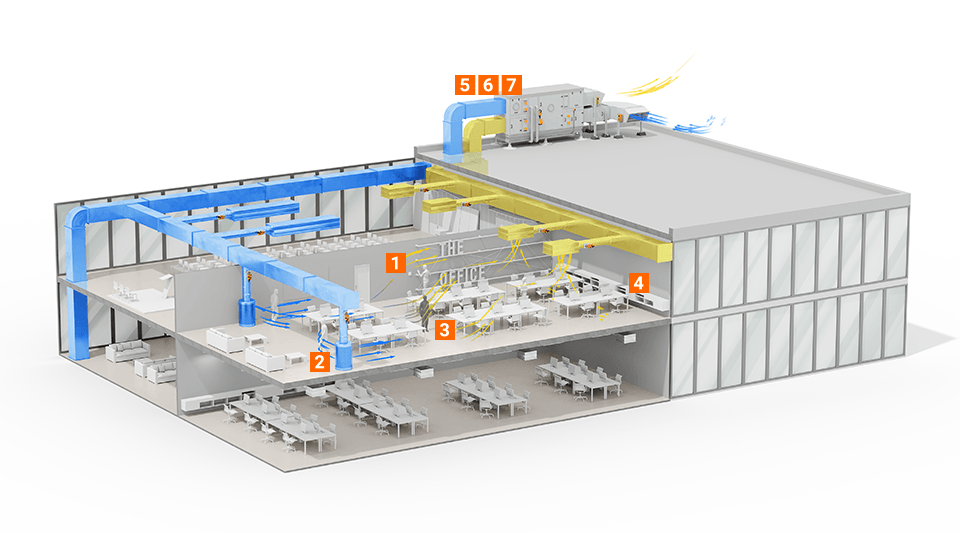
What became most evident was that continuous and reliable measurement, display, and monitoring of indoor air are crucial to maintaining IAQ. The seven essentials include:
- Continuous and reliable measurement, display, and monitoring of IAQ.
- Accurate amount of air supplied to a zone and controlled removal of contaminated air.
- Well-designed air dilution and airflow patterns.
- Active pressurization of envelope and spaces.
- Correct temperature and humidity conditioning.
- Effective filtration.
- Proper amount of outside air.
Interview with Leading Healthy Indoor Environment Consultant – Johanna Trüstedt
“The Data Must Be Readily Available”
Belimo spoke with interior designer and leading healthy indoor environment consultant Johanna Trüstedt. She described the relationship between IAQ and productivity, and explained why, in her view, sensors are the crucial link that will finally make the building occupants’ call for healthy indoor air heard.

Belimo: How would you describe, on a scale of one (worst) to ten (best), the current state of IAQ in buildings worldwide?
Johanna Trüstedt: Interestingly, a lot has changed since the start of the pandemic. Before, I would not have rated the state of our indoor environment higher than, let's say a three or four. Now, many of my customers ask me to have a closer look at their HVAC systems. Therefore, I think in line with greater awareness, I see us now between a five and six.
Are there differences between regions?
Certainly, sensitivity toward air quality is often triggered by the quality of the outside air. Beijing, for example, has very poor outside air, so sensitivity is high. I have also worked on numerous projects in Shanghai, where employers wanted to ensure their employees enjoyed a healthy indoor climate by making sure that the air that comes into the building was “clean“, and that no harmful materials were installed.
And, how about in Europe?
Interestingly, it is not a hot topic here yet, even though the outside air that often enters a building can also be quite poor, especially in city centers or zones with heavy road traffic. Thus, it would make sense to have a closer look at this and change existing norms, particularly regarding PM10 or PM5 (particulate matter). Interior air quality should also be tested, as we often bring materials into our buildings that pollute the inside air.
Where do we stand in the Americas?
The Americas face similar challenges concerning healthy indoor air. Road traffic is certainly one problem, but outside air can also be questionable for other reasons, such as environmental disasters. Because of this, many Americans tend to be more sensitive about this topic. Their approach to addressing this challenge is to certify IAQ – which we are seeing more and more of in the market – and the US building sector is much more aware of this topic. Also, because these certifications can be marketed and are sometimes even used for recruiting purposes, you need to sell them well to the customer. Any stamp makes a product better – this is the way their market works.
Are we naive regarding air quality in Europe?
I would not say naive, rather that we are much more sensitive toward outside air compared to inside air. Knowledge and awareness are simply not there, even though academia is very clear that inside air can be bad for us and influence our productivity. In my opinion, it is the responsibility of HVAC planners and architects to inform building owners about this. I believe we have gone through a similar process with our perception of the consumption of sugar or tobacco, but we are still working on our view of IAQ.
What is the best way to make people aware?
This again depends on the region. In the Americas, certification is working just fine. In Europe, I believe objective evidence is the best method. With interior air testing, it is easy to show that productivity decreases, although it needs to be highlighted that there are a lot of factors that influence productivity. It is tricky to filter out to what degree it concerns indoor air and, here, research is quite thin.
What do the few existing studies say?
They say that the impact of indoor air on us is extreme. For example, Joseph Allen of Harvard University compared the cognitive functions of occupants of poorly ventilated office environments to those in higher ventilated ones. In green building conditions, he proved that productivity increased by 61%, and in green building conditions with enhanced ventilation, productivity increased by 101%. CO2, VOCs, and ventilation rates all significantly and independently affected cognitive function.
“In green building conditions with enhanced ventilation, productivity increased by 101%.”
Amazing, so the payback actually seems to be very clear.
Exactly. A 60% better performance equates to more profits, and we must further highlight this causal relationship, as often a high percentage of operating costs are salaries. If each employee was only five minutes more efficient each day, it would add up! And speed is just one way to look at this. Cognitive functions are also about decision making and crisis response. The results tell a very clear story. There are numerous possible indicators of IAQ, including CO2, PM2.5, VOCs, temperature, and relative humidity.
Which ones do you focus on in your work?
CO2 is generally a solid indicator of air quality, as a lower CO2 concentration often coincides with fewer pollutants. CO2, VOCs, PM2.5, and PM1 – so-called fine dust – are the main influences on air quality and wellbeing, obviously combined with temperature and relative humidity. But the correlation is very complicated as there are, for example, harmful VOCs – such as formaldehyde – but also harmless ones.
What is the most common factor for low IAQ?
We are now actively constructing buildings that are better sealed to save energy, but then the indoor environment is literally running out of air, and this has clear consequences, for example, on pollutant materials. Ventilation is surprisingly efficient at reducing pollution levels but, as soon as the ventilation is turned off, pollution returns to where it was initially. The best option to prevent this would be not to bring any toxic materials into a building in the first place. At the same time, when a building receives certification, this is usually based on one-off measurements, even though materials continue to emit toxic pollutants over the entire life span of that building. However, we cannot rely only on one-off measurements; we need to measure continuously.
This sounds very similar to the so-called “performance gap“ regarding energy efficiency.
Right, readjustments almost never happen once a building has been commissioned. In this regard, I find RESET® accreditation highly valuable, because there is no “A”, “B“, or “C“ stamp you receive for good, rather it needs to be earned continuously through repeated measurements. Once you exceed a threshold, you lose accreditation, but how you get below the threshold is up to you. There are no checklists to follow as with other certifications, only the output counts.
What role do sensors play in this system?
Obviously, a very important one, especially regarding air quality. It is all about continuous measurement rather than selective one-off readings. And another important point in my view is that the data needs to be accessible to the occupants, which, in reality, often proves tricky.
Why?
Because only then can occupants react accordingly and decide for themselves where they want to work and where they don’t. This is what deters many building owners. If you are collecting data that only facility management gets to see, there is no use for it.
So, you basically want to empower the occupants.
Right. The data must be readily available to them so they can make their own decisions. We are not there yet but we will be in the future. For example, we might be able to view the air quality inside a coffee shop from the outside, or even from a mobile app. If it is bad, most of us would probably decide to meet somewhere else. This can be a very strong marketing tool. I like to compare this again to what the food industry went through: consumers had to fight hard for the very detailed list of ingredients on food packaging that we see today. I want the same for buildings and, to be able to display the proper list of ingredients for IAQ, sensors are the key.
“In the future, we might be able to view the air quality inside a coffee shop from the outside.”
So, why do we not do it right away?
Because there is an upfront investment involved. To regulate CO2, you would need mechanical ventilation. Of course, by opening the windows manually, you can also pass this task onto the occupants. Nevertheless, they would need sensors to know when the window should be opened. Also, regarding pollutants, it is not obvious which materials are harmless and which are not. This will take time and investment to determine. But the return on investment is clear, especially once you add the occupant into the lifecycle cost calculation. This is why I am convinced that it is not more expensive in the long run – it is an upfront investment that pays off.
 About the Interviewee
About the IntervieweeJohanna Trüstedt is a workplace and sustainable indoor environment consultant and is on the User Experience Team for Drees & Sommer. She has been creating healthy and user-centric indoor environments for more than 20 years in Germany, Japan, China, Spain, and now in Switzerland. Johanna’s approach involves creating space solutions that support the wellbeing and health of a building’s occupants. She is also a board member of the Schweizerischer Verein für Luft- und Wasserhygiene (SVLW).
 SDG 3: UN Sustainable Development Goals Approach
SDG 3: UN Sustainable Development Goals ApproachBelimo contributes to SDG 3 “Good Health and Well-Being” by ensuring optimum indoor air quality and well-being in rooms. Its intelligent HVAC components control the major factors affecting room climate: temperature, humidity, air flow, CO2, and VOCs. High-performance HVAC systems and proper humidification strategies are required to maintain stable and healthy indoor air quality. For ensuring optimum conditions, Belimo sensors serve as a critical link between the zones and the HVAC system.

